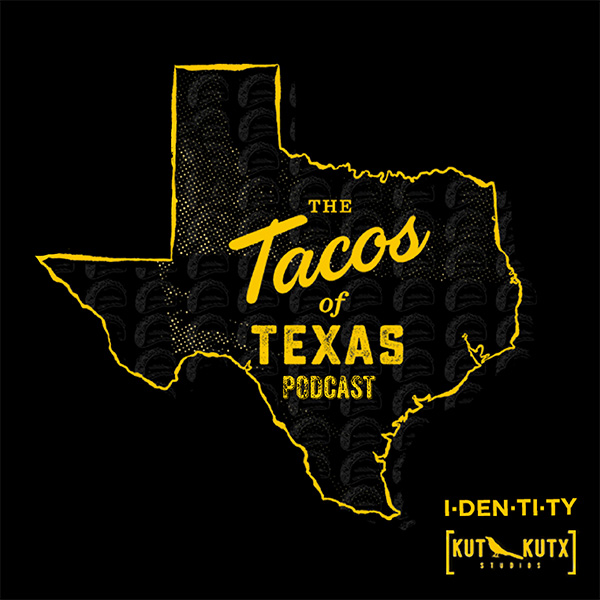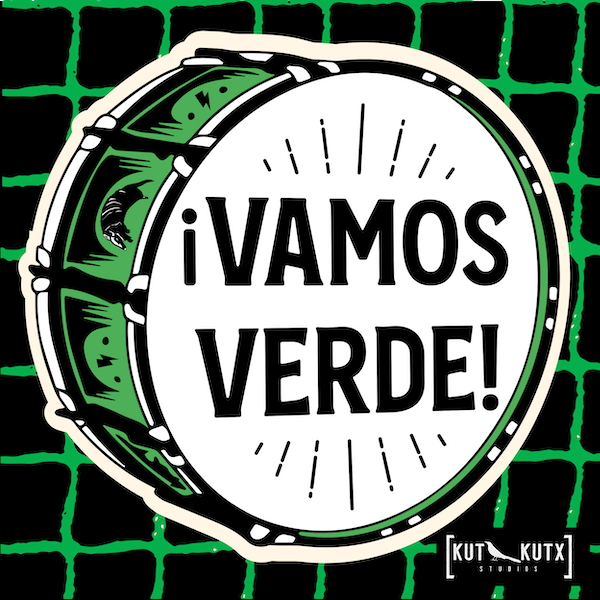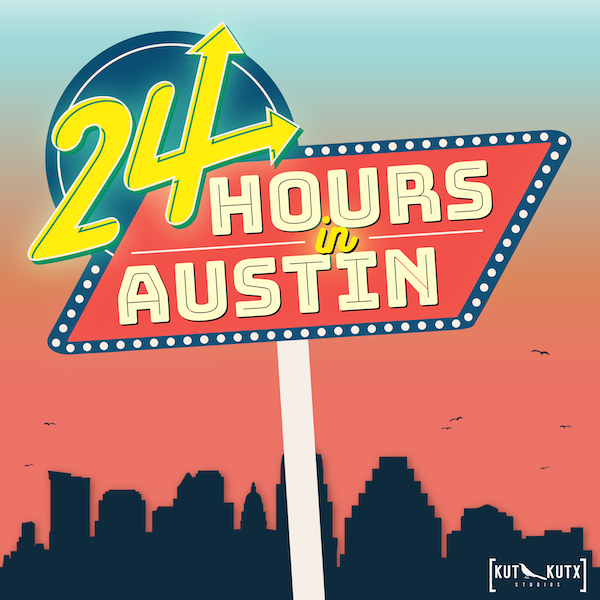Chef Adrian Lipscombe grew up in San Antonio and we’ll discuss Texas foodways from her Black heritage to growing up in the gateway to South Texas, San Antonio. Chef Lipscombe is the founder of the 40 Acres & A Mule Project, a city planner and Culinary Diplomat with the U.S. Department of State.
The full transcript of this episode of Tacos of Texas is available on the KUT & KUTX Studio website. The transcript is also available as subtitles or captions on some podcast apps.
Mando Rayo This is a Tacos of Texas podcast, plus plus plus: bonus episode. [music] What’s up, taco world? I’m taco journalist Mando Rayo and welcome to the Tacos of Texas podcast in partnership with KUT and KUTX Studios. And we’re back exploring taco culture in Texas through the eyes of the people in the Lone Star State. From San Antonio’s iconic breakfast tacos to barbacoa and Big Red, we’ve got it all. In the studio, we’re talking about the intersectionality of Black Mexicans with Chef Adrian Lipscombe, who grew up in San Antonio, Texas. Adrian is the founder of the 40 Acres Project, a city planner and culinary diplomat with a U.S. Department of State. We have Adrian Lipscombe in the studio. She is a fellow hermana, right?
Adrian Lipscombe Hey, yeah.
Mando Rayo That’s right. That’s right. And you’re born and raised in in San Antonio.
Adrian Lipscombe San Antonio. Yeah.
Mando Rayo Tell me, what was that like for you?
Adrian Lipscombe Very interesting. I would say for me, growing up there, I grew up all over San Antonio, so my family’s from the East Side, but I grew up more northeast and northwest. You know, we’d divide San Antonio that way. It’s just really big. So I had a variety of schooling from going to like MacArthur to home. So if people know that it’s a drastic difference.
Mando Rayo Yeah, Yeah. And tell me a little bit about what you’re doing at adie_eats. What is that? What do you do? And tell, tell… give us kind of like the nutshell of what you’re trying to do.
Adrian Lipscombe Yeah, I kind of like, compartmentalize myself again, right? So my background, professional background, I’m an architecture and city planner, so that’s just so unique. But I’m also a chef. So you’re kind of wondering how those worlds kind of collide together. But I really think they really come together really well, complement each other very well, especially when it comes to food and community and understanding how food gets to your community, but also educating people about their food, their culture, their history, which dives into their buildings, the way they move. And it just it just works all well together.
Mando Rayo Nice. Nice. Well, yeah, that’s, that’s one of the first ways that we met. There was a fundraiser. You were one of the chefs cooking. You almost, you know, poisoned me.
Adrian Lipscombe I did not.
Mando Rayo [laughs] We can. We can cut that.
Adrian Lipscombe That was an allergy. Unknown allergy.
Mando Rayo Unknown allergy. I didn’t do my full disclosure.
Adrian Lipscombe You survived. So we’re here today.
Mando Rayo Yeah, yeah, yeah, yeah. Well, Adrian, we’re talking today about this idea around this intersectionality of Black Mexicans. Yeah. And so this idea around, you know, former slaves going and traveling through Texas into Mexico.
Adrian Lipscombe Right.
Mando Rayo But you– I want to get your lived experience through growing up in San Antonio. How do you see some of those flavors coming through as you were growing up in San Antonio?
Adrian Lipscombe I think it’s very you know, I really didn’t know I was anything anything different until I left Texas. And then I realized I’m a different type of Black when I left, when I left Texas. But for me, growing up, it was just it was normal, right? So having tortillas as a snack, eating it with, you know, melted cheese or just butter, that was just something I was used to. Hearing in Spanish on a daily basis. Doing Spanglish on a daily basis was just what I was used to, being called Adriana versus Adrian. You know, it’s just what I was used to and I really didn’t discover I was different or a different type of Black until I moved out. So when it came to culture and food, I was used to eating what people outside of San Antonio or outside of Texas would see as Mexican food or Tex-Mex. So for me, that was just our normal everyday eating. So if we had a celebration, you were going to see charro beans at the table or, you know, salsa and but you would see brisket or you see fried chicken and watermelon. So it was just a combination that you would see between being African or African American and then having Mexican heritage.
Mando Rayo Nice, nice. And so how do you see you know, I think we’re all like novice historians.
Adrian Lipscombe I try to be.
Mando Rayo Right? And we’re trying to trace some of those migration patterns and and foodways.
Adrian Lipscombe Right.
Mando Rayo Right. So can you share maybe some of the things that kind of… What are the those connecting points?
Adrian Lipscombe I think Texas has a very interesting and a kind of like ebb and flow pattern when it comes to African-Americans. You will see like African-Americans, when they first, or the first settler who they say the first one came was like in 1528 or so, came with the Spanish. So, you know, we’re seeing some that are coming from like the Galveston, Houston area, first in a and I believe it was like just by a shipwreck. Right. So they discovered, you know, Texas. You know, and so on that in the Natives already being here, there’s already this immersive culture of understanding that has to come both ways, right through violence, through food, through, you know, conflict and communication. Just what you’re seeing. And then as you continue on, you know, Mexico and the Spanish War is happening, there were things that were happening there included that African or Africans at that time were accepted. So there was a blend of marriages. It was just human life that was happening. But there still was some enslavement that was still coming and accruing. And when you start thinking about the colonization of the Americas coming in, they’re heading towards Texas and and they want the right to bring their slaves. And so there were different laws that allowed whites still be have enslaved Black people. So just think about that being unique that you’ve never been enslaved. This is your natural life, but then you’re watching an enslaved person the same color as you, right? Without the same rights as you. So you’re seeing that happen. And when you’re seeing that Anglo or you’re seeing the whites come in with the enslaved? They’re coming with that East coast, right? They’re coming with that East Coast food, things that we are starting to discover about our food, but also that southern quote unquote, southern food.
Mando Rayo Sure.
Adrian Lipscombe And as you’re continuing on, you saw the Texas revolution happens. You see whites wanting to demand their rights for enslavement. This is where that ebb and flow happens, where you see freed blacks trying to leave. Right. Because now there’s a law that stated they’re not going to be able to own land. And then one, you know, it’s coming up, You’re not going to be free soon, you know. Yeah. So you’ll start seeing where you saw the Underground Railroad starting to happen, heading north and also heading south towards the Rio. And what you’ll see is the difference of food and that food culture, just immersing and changing. And in fact, like we need to just say, you know, Texas was once Mexico, right? So, yeah, you know, so there was already this huge.
Mando Rayo If you don’t know now you know.
Adrian Lipscombe Now you know, so there was already this influence of food and culture and locality of different types of ingredients already here. And that adaptation I find that Africans were very unique on, on being able to adapt or understand. And I want people to really understand that enslaved people did not leave their culture, did not leave their food, did not leave their skills or their knowledge behind. So they had to survive or find a way to survive or were told to survive and and have other people to be able to survive. So adapting those cultures and becoming one with those Natives or Indigenous people, that was just what we had to do, right? So you had influences of flavor coming through. So that’s how we got to kind of where we are today, where you see that usually a conflict ended up changes the amount or the type or our food or ingredients that we’ve seen. So hence Tex-Mex and we can have a whole different conversation about that.
Mando Rayo But you I do see kind of some of the similarities I say like with with hibiscus for example. Yeah, right. So when you, you know, you go, you know, anywhere in Mexico or even here in Texas nowadays, you know agua jamaica.
Adrian Lipscombe Yeah, I mean.
Mando Rayo Right? But then the Caribbeans.
Adrian Lipscombe Yeah it’s sorrel. It has so many names, so sorrel, bisab, sobolo. I mean, there’s like so many different names for hibiscus, but it runs within the same family. Right. And it may be a different type of hibiscus, but, you know, it exists. Right. And for more of African or even African American culture, we use it as like a red drink everybody knows are quote unquote, are starting to understand the red drink that exists. But a lot of people don’t know that that red drink, depending on where you are like the Caribbean, they used it more as for a celebration during the Christmas season, so that’s when it was blooming. So locality about the temperate, how it comes available is when it was being used. Like I said, they didn’t leave their knowledge, Africans didn’t leave their knowledge behind or themselves.
Mando Rayo Right, no no.
Adrian Lipscombe So, you know, in the adaptation of those seeds coming across, it was just a perfect storm. Our weather was just very temperate and the climate just really worked out for these things to be able to grow. So that’s how you see the emergence of these ingredients going across the border both ways. Yeah. And so, you know, for us or for me and even my family sorrel or bisab or hibiscus, you know, we’re used to using it mainly in a drink. But present time, you’re seeing a lot of especially African American chefs starting to dive in more to understand about it and understand its medicinal use as well too, because it was on a personal as an offering. So. We are now seeing more present time of using it more for coloring and for, you know, dyeing of food, bringing of colors, using it in rice. So and, you know, using it for sweets and, you know, mainly mainly for the desserts. Yeah, yeah, yeah.
Mando Rayo Well, you know, I think what you’re talking about is this idea where you have people from different parts of the world coming together and bringing what they have with them.
Adrian Lipscombe Right. It’s survival.
Mando Rayo It’s survival.
Adrian Lipscombe It is. It is a survival and it’s survival of the fittest. And, you know, we’ve lost probably a lot of ingredients and a lot of techniques over time. And, you know, and that’s where I find the curiosity for me is going to be able to go to these different countries and realizing that, you know, hey, we have ingredients like that. And if I’m thinking that I know they were thinking that centuries ago when they came over here and they were like, hey, we have something similar to that, or it is that. So, you know, we can’t just think or limit that one plant only grow on one continent because at one time we were one big continent. So, you know, there may have been a variety or a change due to where it was located at, but it probably has similarities or it was the same thing.
Mando Rayo Yeah. Yeah. And I think back to those Indigenous practices of of Earth ovens, too. Right.
Adrian Lipscombe Mm hmm.
Mando Rayo So those are Native American techniques? Definitely Mexican techniques. Before they were, I would say, recategorized. Then you have, like, barbacoa. I know you have brisket, too.
Adrian Lipscombe Right.
Mando Rayo So. So there’s a lot of.
Adrian Lipscombe There’s a lot. Yeah. And we like if you go and we, you know, when you’re talking about briskets and meats and cooking of meats and digging in pits of holes and putting it in there, you know, when you look at these pictures or historic pictures, you’ll see a lot of white people, but they’re standing outside the pit as a celebration. And people that are inside of the pit are usually brown and Black, you know, because they they understand that. They know the technique. I mean, I know the technique. And that was just through family. You know, it’s like six generations of watching people cook. And it was more of a oral and visual thing that we weren’t writing down or had the capabilities of writing it down. It was the lived experiences of learning how to do this and from growing up from childhood. And so, yeah, you have these techniques and I mean, I was just amazed at watching techniques in Cameroon of how they’re drying fish and, you know, and the relation of how close it is to the fire and then the three stones and the building of the fire and and how they how they do their meat. And it’s kind of like there was this communication going across the border and even across the seas. And, you know, another realization that we have to really think about is that, you know, Columbus wasn’t the first one to travel. You know, like you can’t…
Mando Rayo Or to get lost.
Adrian Lipscombe Or to get lost or to crash, you know? So, you know, I you know, I really believe in and hearts of hearts that, you know, Africans and, you know, people from the South and Indigenous were traveling across the seas and being explorers. We were migrators. We migrated. You know, And so there were probably different sides of trades that were happening. It just was never written documented. Yeah, it was just wasn’t documented. So there were techniques that were were known that were seen across the border. And we’re still discovering them today.
Mando Rayo Mm hmm. Mm hmm. So let’s go back to to you and your kind of experience growing up in Texas, in San Antonio. Obviously. Specifically. You know, when people think of San Antonio, you know, they definitely think of Tex Mex. But they didn’t, they think of, like, population, highly Hispanic. And so how. How do you… What picture do you want to recreate for people?
Adrian Lipscombe It’s so interesting. San Antonio does have a high population or high demographics of of Mexican Americans and immigrants throughout. And it’s a very small population of African-Americans. And it’s mainly people that stayed right and stayed through conflict and war and in centuries of migration. But it’s also a lot of us came from smaller freedmen towns, Maxwell, Lockhart, Little Lane in between areas and even in Austin and have migrated to the larger cities.
Mando Rayo Can you explain to our listeners what a freedman town is?
Adrian Lipscombe Yeah, a freedman town was a town that was developed by enslaved or free slaves, too. They were pretty much segregated, right? So that’s where their businesses were. That’s where they lived. That’s where their grocery store sometimes their Civic was located. And Austin had several of them. San Antonio had several of them or communities. So what you see today is more like large communities, mainly on the east side of different sides of town. So in some of them are significantly still named after some of those areas like Wheatsville, Clarksville, if you recognize those. Those were originally freedmen towns here.
Mando Rayo Okay, great.
Adrian Lipscombe Being black in San Antonio, it doesn’t make me a unicorn. For one thing, you know, San Antonio is very unique because it is diverse. It has a lot of military bases. So you are going to get a diverse culture there. But, you know, it is kind of rare to find people who are African-American that are originally from San Antonio or born in San Antonio. A lot of us have moved on. Our families have generationally moved on. But a majority of us are still on the east side of Austin at this time. And for me, growing up, like I said, it wasn’t any different. You know, we heard the paleta, you know, the guy come down the road. We’re chasing it, too, you know, instead of the ice cream truck, you know. It was just part of my life. And and when it came to food, it was no different. Right. We went to taquerias and we went to we went to our favorite restaurants, our Mexican restaurants that our whole family would go to. And we celebrated when everybody celebrated Fiesta. We were part of Fiesta, you know. So for me, it just seemed that I was part of the culture or immersed. And even though we were small part of it, we were still accepted as being part of San Antonio.
Mando Rayo That’s great. Tell us about your your family roots in San Antonio.
Adrian Lipscombe Yeah. So I will have to go back as far as I know, as my great grandfather, my great grandfather instilled in us of ownership of land because land created like identity and community and also can create an economy. And he purchased land. So him and his siblings purchased a lot of land. And you know, there’s a lot of folktale and folklore you know of him and his family purchasing off the San Antonio River and being kind of swindled out of those pieces of property. But my great grandfather, grandfather James, he stayed in construction, so he owned swaths of land on the east side and I believe also on the west side of of San Antonio. So my family originally or from my great grandfather, he was originally from Maxwell. I was born in Maxwell and eventually moved down to Corpus. But in owning land straight through and my grandmother lived in San Antonio and all her sisters, a majority of her sisters, lived in San Antonio. So we had a staple of family that lived there. And so my mom went to high school, went to Roosevelt. Like I said, we just were originally, like I said, from San Antonio, and then my father’s side again, they were Lockhart Luling and they eventually moved to San Antonio area. And so majority of their family lived off Hay street. And people could recognize us because we all had similar similar eyebrows and similar facial features. And some people probably like I know that family and but they all lived off of some of the same streets over there off of MLK. So, you know, that was our community. So summers that’s where I spent majority of my time. My family’s church was over there. That’s where our family church cookbook was created over there at the churches. And, you know, so that’s how we maintain a lot of our identity within our food. And when you look at those church cookbooks, yes, you did see pound cake. Yes. You did see different types of southern sweets that were very much recognized. But you would also see enchiladas in there. You know, you would see Spanish rice or Mexican rice in there. So and you would see carne guisada. So, you know, there was like a whole array of culture just in these cookbooks.
Mando Rayo Yeah. Love it. Love it. Well, thanks so much, Adrian, for coming into the studio with us. And we’re excited to really follow along and explore this idea of migration patterns and really kind of hone in on this idea of right around Black Mexicans in Texas, and I hope you can come along for the ride.
Adrian Lipscombe Oh, yeah. I’m going to be here. Thank you.
Outro The Tacos of Texas podcast is presented by Identity Productions in partnership with KUT and KUTX Studios. Our host and producer is Mando Rayo. Our audio is mixed by Nicholas Worthen and Ever Calderon. Our story producer is me, Sharon Arteaga. And our creative producer is Dennis Burnett. Music was created by Peligrosa in Austin, Texas, and King Benny Productions, located in the Quinto barrio of Houston.
This transcript was transcribed by AI, and lightly edited by a human. Accuracy may vary. This text may be revised in the future.





